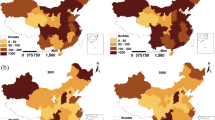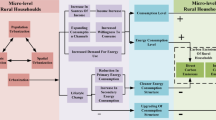Abstract
Environmental pollution, especially agricultural carbon emissions (ACE), has led to public health problems to rural areas in China and accompanied by a heavy medical economic burden. However, most studies on carbon dioxide emissions and healthcare expenditures focused on the industrial sector, and the effect of ACE was overlooked. Therefore, studying the effect of ACE on rural residents’ healthcare expenditures (NHCE) is not only conducive to accelerating the low-carbon transformation of agriculture but also has important implications for reducing healthcare expenditures. In addition, the effect of ACE on NHCE in different areas might be complex and nonlinear due to differences in years of schooling (EDU) leading to different awareness of environmental protection and health among farmers. Therefore, this paper used the Bayesian quantile regression (BQR) model and the panel threshold model to explore the effect of ACE on NHCE in different areas, based on the panel data of 31 provinces in China from 2007 to 2019. The results showed that ACE and NHCE experienced similar spatial distribution from 2007 to 2019. The BQR estimation results found that ACE had a significant positive effect on NHCE at different quantile levels during the sample period, public health concern, and thereby increasing the medical and economic burden of rural households. Meanwhile, ACE had a positive effect on NHCE with a significant single threshold effect from EDU. Specifically, farmers gradually realize the harm of environmental pollution to health with the continuous improvement of education level, and then ACE aggravated the improvement of NHCE after exceeding the threshold. EDU was more essential for farmers in contiguous poverty (CP) areas than in relatively developed (RD) areas and played an important role between ACE and NHCE. Furthermore, demographic structure, economic development, and public services were also positive driving factors for NHCE. The results of analysis provide a valuable reference for understanding the factors influencing NHCE and enable formulation of ACE emission reduction policies according to local conditions.






Similar content being viewed by others
Data availability
All data generated or analyzed during the current study are presented in this article. Raw data will be also accessible from the author group if requested.
References
Ahmad M, Rehman A, Shah S et al (2021) Stylized heterogeneous dynamic links among healthcare expenditures, land urbanization, and co2 emissions across economic development levels. Sci Total Environ 753(1):142228. https://doi.org/10.1016/j.scitotenv.2020.142228
Alexendratos N, Bruinsma J (2012) World agriculture towards 2030/2050: the 2012 revision. ESA Working Papers 288998, Food and Agriculture Organization of the United Nations, Agricultural Development Economics Division (ESA)
Ambade B, Ghosh S (2013) Characterization of PM10 in the ambient air during Deepawali festival of Rajnandgaon district, India. Nat Hazards 69:589–598
Ambade B, Sethi SS, Giri B (2022) Characterization, behavior, and risk assessment of polycyclic aromatic hydrocarbons (PAHs) in the estuary sediments. Bull Environ Contam Toxicol 108:243–252
Ambade B, Sethi SS, Chintalacheruvu MR (2023) Distribution, risk assessment, and source apportionment of polycyclic aromatic hydrocarbons (PAHs) using positive matrix factorization (PMF) in urban soils of East India. Environ Geochem Health 45:491–505
Apergis N, Gupta R, Lau C et al (2018) U.S. state-level carbon dioxide emissions: does it affect healthcare expenditure. Renew Sust Energ Rev 91:521–530
Cao GL, Zhang XY, Wang YQ, Zheng FC (2008) Estimation of emissions from field burning of crop straw in China. Chin Sci Bull 53(5):784–790
Chaabouni S, Zghidi N, Mbarek MB (2016) On the causal dynamics between CO2 emissions, health expenditures and economic growth. Sustain Cities Soc 22:184–191
Chen L, Zhuo Y, Xu Z, Xu X, Gao X (2019) Is carbon dioxide (CO2) emission an important factor affecting healthcare expenditure? Evidence from China, 2005–2016. Int J Environ Res Public Health 16(20):3995. https://doi.org/10.3390/ijerph16203995
Dietterich L, Zanobetti A, Kloog I et al (2015) Impacts of elevated atmospheric CO2 on nutrient content of important food crops. Sci Data 2:150036
Grossman M (1972) The demand for health: a theoretical and empirical investigation. Columbia University Press, New York, National Bureau of Economic Research
Hansen BE (1999) Threshold effects in non-dynamic panels: estimation, testing, and inference. J Econom 93(2):345–368
Hao Y, Liu S, Lu ZN et al (2018) The impact of environmental pollution on public health expenditure: dynamic panel analysis based on Chinese provincial data. Environ Sci Pollut Res 25:18853–18865. https://doi.org/10.1007/s11356-018-2095-y
Huang SL, Hsu MK, Chan CC (2003) Effects of submicrometer particle compositions on cytokine pro-duction and lipid peroxidation of human bronchial epithelial cells. Environ Health Perspect 111:478–482
Huang X, Xu X, Wang Q, Zhang L, Chen L (2019) Assessment of agricultural carbon emissions and their spatiotemporal changes in China, 1997–2016. Int J Environ Res Public Heal 16(17):3105
IPCC (2006) 2006 IPCC guidelines for national greenhouse gas inventories (IPCC National Greenhouse Gas Inventories Programme). https://www.ipcc-nggip.iges.or.jp/public/2006gl/index.html
IPCC (2021) AR6 climate change 2021: the physical science basis (2023-08-21). https://www.ipcc.ch/report/ar6/wg1/#SPM. Accessed 21 Aug 2023
Jacobson MZ (2008) On the causal link between carbon dioxide and air pollution mortality. Geophys Res Lett 35(3):130–134
Jerrett M, Eyles J, Dufournaud C, Birch S (2003) Environmental influences on healthcare expenditures: an exploratory analysis from Ontario. J Epidemiol Commun H 57(5):334–338
Jiang Y, Chen S, Hu B, Zhou Y, Shi Z (2020) A comprehensive framework for assessing the impact of potential agricultural pollution on grain security and human health in economically developed areas. Environ Pollut 263:114653
Khoshnevis YS, Khanalizadeh B (2017) Air pollution, economic growth and healthcare expenditure. Econ Res-Ekon Istraz 30(1):1181–1190
Kumar A, Ambade B et al (2020) Source identification and health risk assessment of atmospheric PM2.5-bound polycyclic aromatic hydrocarbons in Jamshedpur. India. Sustain Cities Soc 52:101801
Liu K, Shang Q, Wan C (2018) Sources and health risks of heavy metals in PM25 in a campus in a typical suburb area of Taiyuan. North China Atmos 9(2):46
Mahato DK, Sankar TK, Ambade B et al (2023) Burning of municipal solid waste: an invitation for aerosol black carbon and PM2.5 over mid–sized city in India. Aerosol Sci Eng 7:341–354
Matteo LD, Matteo RD (1998) Evidence on the determinants of Canadian provincial government health expenditures: 1965–1991. J Health Econ 17(2):211–228
Mcdonald AJ, Balwinder S, Jat ML, Craufurd P, Gerard B (2020) Indian agriculture, air pollution, and public health in the age of covid. World Dev 135:105064
Medek DE, Schwartz J, Myers SS (2017) Estimated effects of future atmospheric CO2 concentrations on protein intake and the risk of protein deficiency by country and region. Environ Health Perspect 125(8):087002
Myers S, Zanobetti A, Kloog I et al (2014) Increasing CO2 threatens human nutrition. Nature 510:139–142
Qi XH, Ye SL, Cheng Y et al (2013) The game analysis between poverty and environment in ecologically fragile zones. Acta Ecol Sin 33(19):6411–6417
Saida Z, Kais S (2018) Environmental pollution, health expenditure and economic growth in the Sub-Saharan Africa countries: panel ARDL approach. Sustainable Cities and Society 41:833–840. https://doi.org/10.1016/j.scs.2018.04.034
Smith M, Myers S (2018) Impact of anthropogenic CO2 emissions on global human nutrition. Nature Clim Change 8:834–839
Smith M, Myers S (2019) Global health implications of nutrient changes in rice under high atmospheric carbon dioxide. Geohealth 3(7):190–200
Smith M, Golden C, Myers S (2017) Potential rise in iron deficiency due to future anthropogenic carbon dioxide emissions. GeoHealth 1:248–257
Sousa E, Quintino V, Palhas J et al (2016) Can environmental education actions change public attitudes? an example using the pond habitat and associated biodiversity. PLoS One 11(5):e0154440. https://doi.org/10.1371/journal.pone.0154440
Springmann M, Mason D, Robinson S et al (2016) Global and regional health effects of future food production under climate change: a modelling study. Lancet 387(10031):1937–1946
Tian F, Gao J, Yang K (2018) A quantile regression approach to panel data analysis of health-care expenditure in Organisation for Economic Co-operation and Development countries. Health Economics 27(12):1921–1944. https://doi.org/10.1002/hec.3811
Tian Y, Yin MH (2022) Re-evaluation of China’s agricultural carbon emissions: basic status, dynamic evolution and spatial spillover effects. Chin Rural Econ 447(3):104–127
Valin H, Sands R, Mensbrugghe D et al (2014) The future of food demand: understanding differences in global economic models. Agric Econ 45:51–67
Wang ZH, Mansoor M, Asghar HSA, Zaidi WB (2019) Dynamic linkages among Co2 emissions, health expenditures, and economic growth: empirical evidence from Pakistan. Environ Sci Pollut Res 26:15285–15299
West TO, Marland G (2002) A synthesis of carbon sequestration, carbon emissions, and net carbon flux in agriculture: comparing tillage practices in the United States. Agric Ecosyst Environ 91(1–3):217–232
Wordley J, Ayres W (1997) Short term variations in hospital admissions and mortality and particulate air pollution. Occup Environ Med 54(2):108–116
Wu X, Zhang J, You L (2018) Marginal abatement cost of agricultural carbon emissions in China: 1993–2015. China Agric Econ Rev 10(4):558–571. https://doi.org/10.1108/caer-04-2017-0063
Xie W, Li G, Zhao D, Xie X, Wei Z, Wang W, Wang M, Li G, Liu W, Sun J et al (2015) Relationship between fine particulate air pollution and ischaemic heart disease morbidity and mortality. Heart 101(4):257–263
Xu X, Xu Z, Chen L, Li C (2019) How does industrial waste gas emission affect healthcare expenditure in different regions of china: an application of Bayesian quantile regression. Int J Environ Res Public Heal 16(15):2748
Xu X, Zhang N, Zhao D, Liu C (2021a) The effect of trade openness on the relationship between agricultural technology inputs and carbon emissions: evidence from a panel threshold model. Environ Sci Pollut Res 28(8):9991–10004
Xu X, Yang H, Yang H (2021b) The threshold effect of agricultural energy consumption on agricultural carbon emissions: a comparison between relative poverty regions and other regions. Environ Sci Pollut Res 28:55592–55602
Yang S, Fang D, Chen B (2019) Human health impact and economic effect for PM25 exposure in typical cities. Appl Energy 249(SEP.1):316–325
Yu K, Kerm P, Zhang J (2005) Bayesian quantile regression: an application to the wage distribution in 1990s Britain. Indian J Stat 67(2):359–377
Yu K, Moyeed RA (2001) Bayesian Quantile Regression. Stat Probabil Lett 54(4):437–447
Zheng R, Zhang ZL, Zhang XX (2020) Higher education, public health awareness and health behavior: a discussion of the impact of college enrollment expansion on COVID19 epidemic prevention and control. Rev Econ Manag 36(06):5–15
Funding
This work was supported by the Program of the National Social Science Fund of China (grant/award no. 21&ZD153) and Research team on agricultural modernization and industrial innovation and development (grant/award no. CJSYTD201710).
Author information
Authors and Affiliations
Contributions
Yuling collected and analyzed the data and wrote the first draft of this paper. Junyin and Na supervised this project, reviewed results, and edited the manuscript. Chengjie worked for the manuscript review.
Corresponding author
Ethics declarations
Ethics approval
The locations of material collected here are neither privately owned lands nor protected areas. No specific permits were required for our research.
Consent for publication
Not applicable.
Conflict of interests
The authors declare no competing interests.
Additional information
Responsible Editor: Lotfi Aleya
Publisher's Note
Springer Nature remains neutral with regard to jurisdictional claims in published maps and institutional affiliations.
Rights and permissions
Springer Nature or its licensor (e.g. a society or other partner) holds exclusive rights to this article under a publishing agreement with the author(s) or other rightsholder(s); author self-archiving of the accepted manuscript version of this article is solely governed by the terms of such publishing agreement and applicable law.
About this article
Cite this article
Hu, Y., Tan, J., Zhang, N. et al. Effect of agricultural carbon emissions on farmers’ health expenditure of China: evidence from the educational threshold effect. Environ Sci Pollut Res 30, 102586–102603 (2023). https://doi.org/10.1007/s11356-023-29559-6
Received:
Accepted:
Published:
Issue Date:
DOI: https://doi.org/10.1007/s11356-023-29559-6




